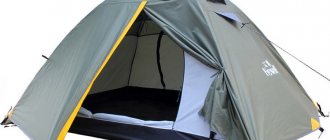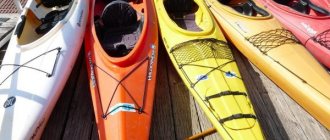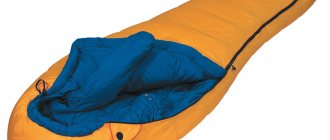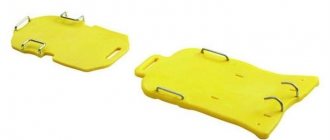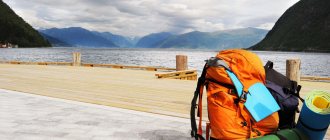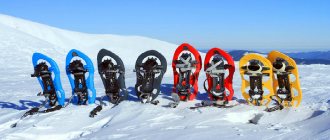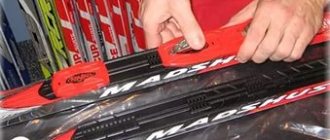Table of contents
Special touring bike
What trip are you going on?
The main qualities of a bicycle for travel:
- Simplicity
- Bike weight
- Possibility of installing a trunk
Which fork is best for hiking?
Mountain, road or road – which is better?
Wheel size
Steering wheel shape
Will the seat be comfortable?
What's good about a touring bike?
The touring car already has a trunk installed. And this is the most important thing for tourism. Traveling without a trunk is complete garbage. There are craftsmen who ride with a special trunk attached under the saddle. But this is for minimalist travelers, for whom every kilogram seems like a burden. You can read about minimalism in a special article.
The touring car also has a steel frame. Not aluminum, not carbon. Just chromed steel. This is done specifically for very long trips where anything can happen. On such trips, not just countries are passed through, but entire continents. And if suddenly a major frame failure occurs, then any mechanic at a car service center can weld the broken parts. Because it’s great, it’s made of steel. But only special craftsmen can weld a broken frame onto aluminum.
Touring bike Ridgeback Panorama 2019
That's all. As a bonus, you will also have wings, a bell and more bottle holders. A touring bike is no different from a regular bike. Think about it, are you ready to overpay for a trunk and a steel frame?
Experts will begin to cleverly say that touring cars have a special geometry and you can ride for several days in a row without harming your back, arms and knees. And in some ways they will be right.
Touring bike wheels
Self-assembly is when you come to a store, and they sell you rims and hubs, you take it all to the bike mechanic, he calculates the length of the spokes in a special program and assembles a set of wheels for you.
Factory or so-called “wheelsets” are usually beautiful, high-tech, bright wheels with a small number of spokes and rims and bushings of non-traditional spokes. These wheels are assembled at the manufacturer's factory.
Such wheels have good quality, roll, and rigidity, but repairing such wheels away from home is often difficult. The point here is the spokes of unconventional shape and length, as well as bushings and rims. Such wheels rarely have standard hubs and regular 32 spokes.
Therefore, for a reliable bike for long bike rides, we will collect wheels. The advantage of this assembly is that in almost any city, if a rim, spoke or hub breaks, you can restore your wheels in any halfway decent workshop or on your own.
As practice shows, it is the wheels that sometimes come first in terms of damage on bicycle trips. Low-quality spokes often burst or fly out, aluminum nipples crack, cannot withstand the load of the rim, and bushings jam or begin to play. Wheels for rim brakes will be slightly cheaper than wheels for disc brakes.
Touring hubs
Bushings come in both bulk and sealed bearings in a cage (so-called industrial bearings, “industrial bearings”). Which bushings are better is, again, a topic for a separate article.
In tourism, what is important to us, first of all, is maintainability and interchangeability of components. Therefore, bushings on bulk bearings can be used in tourism without any problems.
Shimano produces a wide range of different classes of bushings on bulk bearings. They are all quite reliable, easy to move and repair even in the field. And if such a hub does fail you away from home, it’s quite easy to find a replacement, since the flanges of these Shimano hubs come in the same size, and you don’t have to look for spokes of a different size in order to re-spoke the wheel.
The best hubs for touring are Shimano XT and XTR hubs. It is these two lines that have been distinguished in recent years by high quality workmanship and smooth running. Shimano LX/SLX hubs are a good choice. They are very inexpensive and quite reliable.
Shimano Deore, Alivio, Acera hubs are also, oddly enough, reliable, but their quality of dirt protection and smooth running is somewhat worse and would not be the best choice for tourism.
Some people blame the quality of the drum of Shimano bushings, but the bushings of this company have been used under my bicycles for more than 100,000 km and were replaced only as planned - due to the exhaustion of their service life.
Slip bushings are also a great option, especially from reputable manufacturers. In my practice as a mechanic in 2015 and 2016, I increasingly installed bushings from OEM manufacturers to my friends. The idea here is that there is a certain factory in China that produces products for famous brands. And on trading platforms he offers exactly the same bushings cheaper under other brands or “no name”. Such bushings will be of very high quality, and their price-quality ratio will surprise even seasoned travelers and bike mechanics.
Bicycle rims
The rims must be double and pistoned. Because the pistons take on part of the load from impacts and uneven roads.
Some reputable companies, such as ztr, american classic, produce rims without pistons. This is apparently done to reduce weight. These rims are used to assemble lightweight wheels for cross-country racing. But my practice of assembling such wheels shows that these rims behave quite well, with some exceptions, even in cycling touring conditions.
A touring rim should not weigh less than 400 grams. Still, the main part of the load from driving falls on the rims.
It is advisable to choose a welded rim seam, but riveted ones are also quite suitable. I use Mavic 719 rims on my bikes. Weighing less than 440 grams, they have good stiffness, strength and reliability.
A good choice would be rims from the following companies: DT Swiss, Ambrosio, WTB, Sun Ringle, Alex rims, Mach.
When purchasing, pay attention to your weight. If it is approaching or exceeds 100 kg, choose a heavier rim, if you are a fairly light rider, then go for a lighter rim.
My wife is a fairly light girl and carries minimal weight on her bike, so I installed rims on her wheels that weigh only 360 grams each.
If you want to build a budget bike, you don't have to buy too expensive rims. There are always more budget-friendly inexpensive models on the market, which I always use for assembling wheels without any problems.
Spokes for reliable wheels
For the ideal touring bike, there are only two brands of spokes you can use. This is either DT Swiss (Switzerland) or Sapim (Belgium). All knitting needles from other companies, alas, will sooner or later begin to break.
The best option for a touring bike would be DT Swiss Champion or Sapim Basic spokes. These are simple, reliable knitting needles at a relatively low price, 2 mm wide.
There are also variable profile spokes. For example, DT Swiss Competition / Sapim Force. The thickness of the thread and head is 2 mm, and in the middle it is 1.8 mm. They are somewhat more expensive, and will also be a completely reliable option.
It is very important that the length calculation for your set is made as accurately as possible. There are many programs for calculating the length of spokes, but not all of them can be trusted.
All my wheels are built on DT Swiss or Sapim spokes. I personally don’t trust other knitting needles. I tried Taiwanese Pillar, American Wheel Smith and, alas, they all broke sooner or later. Please note that branded knitting needles are branded. And I often saw how, in the workshops of various stores, unscrupulous “masters” passed off cheap Chinese knitting needles as branded ones, which subsequently burst. Therefore, buy knitting needles yourself and contact those you personally trust.
Wheel assembly nipples
The nipple is the part that attaches the spoke to the rim. It is better to use brass nipples. Although I have been driving aluminum nipples for several years now and have not experienced any problems with them.
But still, brass will be better. It is better to take the nipple length 14 mm. Again, use only branded nipples and do not fall for the tricks of sellers. Chinese nipples, alas, are far from ideal quality. You can ride them, but I wouldn’t go on a serious trip.
Rim tape
Many cyclists save money on rim tapes, and this, in my opinion, is a very important part of any bicycle. Poor-quality rim tapes, electrical tapes, and all sorts of strange medical plasters that various cycling people use can cause a lot of trouble for a cyclist. Use quality tapes from reputable manufacturers. It is best if these are self-adhesive tapes.
Tires for bicycle trips
For an ideal bike for cycling, racing bicycle tires weighing less than 400 grams per tire will not be suitable. Such tires will provide better rolling, but will prick too often. The sidewall of such rubber can easily be cut by glass or a sharp stone, which, in fact, happened to me a couple of times away from home.
It is best to choose high-quality and not the cheapest bicycle tires. When purchasing, be sure to feel the thickness of the sidewalls and pay attention to the casting of the tire. The best tires for cycling with puncture protection are produced by Hutchinson, Continental, and Schwalbe. You can choose something from Maxxis.
Over my more than 15-year cycling career, I have changed and tested more than 100 sets of different bicycle tires; you can read reviews of some of them in the bicycle spare parts section.
Choose tires that suit your hiking style. For asphalt hiking, a semi-slick tire is best. For unpaved areas, take tougher tires.
Tubeless tires for cycling touring are generally not bad, but in the event of a large cut or puncture, you will still have to put a tube inside the tire, besides, if your tubeless tire goes flat for no reason, then you won’t be able to inflate it with an ordinary small camping pump It will work out because it will be necessary to pump up too much pressure. However, here is an example of a successful and not the easiest hike on tubeless tires.
Bicycle cameras
A camera is a camera. People haven't come up with anything new in 100 years. You probably shouldn't buy too cheap Chinese cameras. It is best to use a camera with an auto-nipple. My experience shows that cameras with such a nipple are more reliable. In addition, if the pump breaks down, almost any car enthusiast will be able to help you inflate the tire.
Puncture resistant tape
In my practice, at one time I used a tape that protects a bicycle tube from punctures. The thing is generally not bad and quite necessary, especially if your tires often get punctured. I always have similar tapes in my workshop and install them for people who want to save on buying expensive touring tires.
Choosing the right bike for tourism
First you need to decide what kind of trips, for what distance and for how long are you going to travel?
Where will your route be? Off-road and dirt roads, with occasional forays onto the asphalt to stop at a piece of civilization - wash, buy food and go back into the thicket of the forest or jungle.
Then of course you need wide tires and a reliable frame with a sporty riding position. The attachments are preferably the simplest, but simple does not mean cheap. And something that you can fix yourself. So that in the middle of the swamp slurry you can straighten the wheel, rear derailleur, change the tires.
On off-road and sloppy roads you need to ride on a prepared bike
But if, on the contrary, you travel mainly along highways, sometimes only going onto dirt roads. This means speed is important to you - which means thinner tires and a frame with road bike geometry, where the top tube is horizontal to the ground. You can choose a different combination of stars. When traveling from city to city, you don’t have to worry about attachments and switches and you can install advanced solutions.
Touring transmission
The first question is Shimano or SRAM. Before 2009, I liked SRAM much more because of the shift quality. In 2009 I switched to Shimano, and I have no regrets. A tangible advantage of Shimano is that components from this company can easily be found on the shelves in regional stores, since SRAM is mostly available in online stores or only in large cities. Let's say if your SRAM derailleur is broken, it will be more difficult to find a replacement away from home.
Number of speeds. Personally, I drive a 27-speed transmission. Some people drive at 24 speeds, others have already switched to 30 speeds or even 1 to 11.
Here, to be honest, there is not much difference. The only disadvantage of a 30-speed transmission is that the chains and sprockets are thinner, and all this wears out more quickly. But in general, since 2013, almost all the top groups of Shimano and SRAM companies have been producing products with 30 speeds (10 stars on the back of the cassette).
In the hiking world, one of the best groups of more affordable touring equipment is considered to be Shimano XT. This is true. True, their rear derailleur is somewhat unreliable due to the aluminum tab, which is easy to bend and break, so on my bikes I use SLX or Saint derailleurs.
The Saint and SLX equipment groups performed very well in cycling tourism. Deore as a whole also works without problems, but its reliability is percent lower. If we talk about the inexpensive Shimano Alivio group, be it the old 3x8 group or the new 3x9, it copes with the tasks quite well, although it is heavier and less technologically advanced than higher groups, and, of course, works a little worse in super-heavy modes and is less durable .
Again, based on the cyclist’s needs and budget, you can always select some fairly high-quality transmission elements.
If we talk about the specific choice of a particular system of connecting rods, shifters, cassette, chain, then this is a topic for other articles. I highly recommend that beginners read my articles, in which I talk about each group of SRAM and Shimano equipment in a fairly similar way.
Simplicity
When traveling, you need to enjoy the trip, visiting new places, cities, getting to know different cultures and people. And spend less time on everything else, including maintaining your bike. Therefore, simplicity is a very important quality.
The main thing is not to overdo it with travel junk
I have seen many cyclists who make a Christmas tree out of their bike, hanging the bike with various holders, flashlights, speakers, lights and bags. And every crap is very important and impossible to do without. I have to admit, Wasserman's style is not my choice for travel. Try to think less about decorating and hanging on your bike, and think more about how you can maintain your bike on the road.
Touring bike steering column
The thing seems to be unnoticeable, but it depends on it how smoothly your steering wheel turns. Steering columns come in different standards. The main thing is that you need to make sure that it fits your head tube type. When installing the steering column, it is very advisable to trim the steering tube so that it fits evenly and without distortions. Good steering columns cost about $30. Personally, I trust Cane Creek. Their products are the most durable and easy to use.
There are speakers with needle bearings, and others with “miss”. The needle ones cost mere pennies, and they are easy to replace; the “prom” ones are more expensive. Both one and the other are suitable for tourism.
Simplicity of the braking system
The simplest braking system using conventional v-brake pads. But now most bicycles are sold with disc brake systems. They work faster, are more reliable and do not wear out as quickly if your trip involves a lot of descents from passes. But entry-level disc brake systems will weigh an extra kilogram, while pads weigh virtually nothing.
To transport a bicycle on an airplane, steel wheels will have to be removed and then installed. Otherwise, during flight they risk bending and becoming unusable.
Unfortunately, rim brakes are gradually disappearing from production and more models are being produced with disc brakes. In this case, you should choose easy solutions, preferably mechanical ones. Because I can’t imagine how to set up hydraulics in the event of a breakdown far from civilization and bike shops.
Which brakes can you adjust or repair faster? Disc or v-brake pads?
Ease
It is very important how much your bike weighs. We all think that it is the bicycle that carries us along the road. But this happens only because we apply the force of our legs to the pedals to move the iron unit and the person sitting on it. That is, when moving, you shift your own weight + the weight of the bike + the weight of your luggage. This is not so noticeable on straight roads and on descents, but it is strongly felt on climbs.
I have to tell you some bad news. The weight of the bike is not indicated on the store’s website and is not indicated on the manufacturer’s website. Because the weight depends on the frame size. If you find a store where a specific weight is written, you should not believe this information. Therefore, you need to buy a bike in person, and not online. You need to hold it in your hands and estimate how much it weighs. While traveling you encounter various obstacles. You will have to drag the bike over the rails, up the stairs.
I do not recommend buying a bike that weighs more than 12 kilograms. When traveling, every extra gram will pull you back. Therefore, I advise you to find a bike that weighs no more than 10-11 kilograms. Twelve is the maximum. Lightweight frames are not cheap. But sometimes you come across good versions of last year’s collections.
Touring pedals
The best choice, of course, would be Shimano clipless pedals, model 540. They are very well made, are no different in essence from the XT model, they are easy to use and very durable.
It is very important to choose comfortable cycling shoes for such pedals. Again, Shimano produces a large range of cycling shoes for tourism. I have already written in more detail about contact pedals here.
If you are a supporter of “treadmills” (platforms), then choose pedals from well-known companies strictly with closed rolling bearings, or, as people say, “on the slip”.
Possibility to put a rack on a bike
After lightness and simplicity, the next parameter is the ability to attach the trunk . If the frame does not have special holes for a rack, then this bike cannot be used for trips that last longer than 10 days. You simply won’t have anywhere to attach your bike backpack. The holes should be on the frame dropouts where the rear wheel is mounted, as well as under the seat. There are models where there are holes only at the bottom, near the wheel. You can also take such a big one, since the trunk is easily attached to the brake system bolt from above. I have special instructions about this here.
If the seller starts trying to persuade you to buy a bike without holes on the frame and convinces you that you can buy a hinged rack that is attached to the seat tube, do not agree. Believe me, it’s better to go around and look for another option to securely strengthen the trunk. Hinged roof racks have their own drawbacks in fastening and are limited by the weight that can be transported on them without breaking, and this is no more than 15 kg.
Which bike rack to choose
Fork
And here I can say without a doubt that a rigid fork (rigid) is preferable for a touring bike.
A suspension fork is only needed for mountain biking competitions. And a good fork sometimes costs more than the frame itself. Do you have money for this?
There are several advantages of a rigid fork:
- the whole bike becomes 2 kg lighter
- rolling improves, the applied forces are not dampened by the spring fork
- better aerodynamics
Mountain, road or gravel?
It doesn’t matter, choose from what you can find in your city.
Mountain bikes often have holes on the frame for the rack. And you still need to look for a highway with holes. On the other hand, a mountain bike has a hydraulic fork. But for travel you need a hard one. I started out traveling on a mountain bike, and now I ride a thousand or more kilometers on a road bike tuned for touring and multi-day trails.
But you’re in luck, because with the growing popularity of cycling, manufacturers began to produce special bicycles for bikepacking - gravels . What kind of animal is this? These are bicycles designed for small cycling trips of 2-3 days, when you do not need to carry a lot of equipment with you. Which means no trunk. All equipment and things are packed in special bikepacking bags, which are attached to the frame.
But if you look closely at the dropouts, some models still have holes for attaching the trunk. This means that the gravel turns into an ideal touring vehicle. If you can’t install a trunk, then it’s time to think about reducing the amount of junk you carry with you.
With a gravel you get a rigid fork with clearance to accommodate wide tyres. Ram steering wheel for different grips on long trips. With narrow handlebars you get more mobility and control.
And the coolest thing is that when you get home and unfasten the bags and change the tires, your bike turns into a regular road bike.
Bicycle for bikepacking
Traveling with a minimum of things
Touring bike frame
The frame is the heart of any bicycle. It is the frame that almost 50% determines how the bike will behave on various types of road surfaces, what kind of roll it will have, and how stiff it will be. And 70% is appearance.
The most important and basic thing is that the frame suits your height strictly. Don't go with a smaller frame and buy longer stems or offset seatposts. And on a frame larger than yours, you will feel uncomfortable.
The second is the geometry of your frame. Personally, I am a proponent of the time-tested “rolling” geometry of cross-country frames. The head tube/seat tube angle is 70-73 degrees. Naturally, deviations of 1-2 degrees are allowed.
The frame can be for wheels 26", 27.5", 28-29". But the practice of visiting bicycle shops and local bicycle markets shows that in Russia the most common wheel standard is 26”, a little less often – 28-29”. At any Sunday market in any regional center you will always buy a tube, rim or tire for such bicycles.
Your frame can be aluminum, titanium, steel or carbon. Yes, don’t laugh, but I know a couple of cyclists who quite successfully travel distances of more than 1200 km on carbon frames. However, it is worth noting that the reliability of such frames is not at the highest level. Still, carbon fiber is not as reliable as metal. I would never buy a frame like this for tourism.
The choice of material for the frame is the topic of a separate article. Let me just say that in my arsenal for long-distance cycling trips there are two bicycles: on an American Cannondale aluminum frame of alloy 6061 and a custom-welded titanium frame. There is also a third bike on the Trek Crossrip aluminum frame for smooth and good roads. I also tried steel, also very good frames.
Aluminum, in my opinion, is stiff and fast. Titanium is more comfortable. Reliability is the same. There is an opinion that aluminum accumulates fatigue and can suddenly break, but in my practice as a bicycle mechanic, I have never in my life seen a single broken aluminum bicycle frame due to the fact that it has traveled a large number of kilometers.
Steel (chrome-molybdenum) frames also absorb minor road irregularities, but are much heavier than titanium and aluminum, ride worse uphill and, alas, are susceptible to corrosion in winter. But, in general, a steel (chromolybdenum) frame for tourism is a very good option and quite reliable. Such frames roll down the mountain with good health and have good inertia. True, the main disadvantage of steel frames is the instability of the carriage unit, i.e. When you press the pedal sharply and powerfully, the steel frame moves slightly to the side. This is why racers never use steel to compete.
However, many touring bicycle frames are made from Cr-Mo alloy. Firms Surly, On-One, Salsa and others have long started producing quite reliable frames for tourism. But if we take the domestic Russian market, and in general the market for relatively inexpensive and reliable bicycle frames and bicycles, then aluminum will be the most affordable material.
If you are buying an aluminum frame, pay attention to its pedigree. It is best if this frame is from well-known manufacturers, such as Specialized, Trek, Gary Fischer, Scott, Canonndale, Felt, Marin, Giant. Practice from my experience shows that it is the frames of these companies that have the best driving characteristics. This does not mean that frames from other companies will roll worse or be less durable. It’s just that here I have listed exactly those companies that are constantly conducting their own developments in the bicycle industry, and do not stupidly order their products from the catalogs of large Chinese factories.
There are also many other local companies that produce high-quality bicycle frames. Such companies have a claim to a certain exclusivity, and the quality of their frames, as a rule, is always at its best.
Another important detail of a frame for a touring bike is the presence of a full-fledged rack mount. Of course, there are some ways to securely install a trunk on a frame that does not have fasteners, but these methods are sometimes somewhat artisanal or require some financial investment.
It is also worth paying attention to the inconspicuousness of the frame. You shouldn’t buy a frame in overly bright colors. We live, alas, in Russia, and often in the outback we have to deal with criminal elements of society. So there is no point in attracting attention with a beautiful and expensive bicycle once again. Just in case, I recommend that the reader go to the article section and read there my material about safety on bicycle trips , which at one time received a large number of responses among fellow cyclists.
Let's also not forget about the weight (mass) of the frame. For tourism, you should not buy or order frames that are too light. The thinner the frame pipes, the less reliable the frame will be. The normal weight of a reliable titanium or aluminum frame in an 18” size should be from 1700 to 2100 grams. Steel must weigh at least 2400 g.
I think it’s unnecessary to remind you that the frame must have the necessary fastenings for your desired type of brake use. In general, inexpensive frames from not very well-known manufacturers can be used for tourism, but the main thing is that such a frame should still be of high quality. A titanium frame will probably be your best choice. I ride titanium, but I ordered a similar frame back when prices for titanium were acceptable for the average consumer in Russia.
If your budget is more modest, then don’t be upset; feel free to take a good aluminum frame.
Travel bike wheel size
Mountain bikes usually have wheels with a diameter of 26 inches, while gravel and road bikes have wheels with a diameter of 28 inches. If you ride on flat terrain, you will feel the benefits of a larger wheel on a road bike. You pedal less, but the bike has already gained a decent speed. On a mountain bike you will have to pedal more often. But if on your trip there are a lot of passes, then it will be easier to climb mountains on 26 wheels, and both bikes go down the hill the same way. So decide for yourself on the diameter. It’s also worth noting that if you ride in Russia or Asia, you can buy tubes and tires for 26” at any sports store. Finding the right size for a road bike will be problematic. You will have to carry a spare tire with you. When I was driving around Australia I had several tubes and one spare tire. And it was useful to me. True, this happened in the most deserted Nullabor desert. There are no bike shops there either.
What is the difference between a car nipple and a presta nipple?
There is also a difference in the nipples. There is an automobile nipple for which all pumps are suitable. Or a “presta” nipple. It's thinner, but that's not a big problem. Recently, compact and powerful pumps have been made. All I use for the road nipple is a small adapter hose (20 grams) in the repair kit.
Bicycle handlebar shape
A road bike has a ram handlebar. It takes some getting used to, but then you can use different hand positions to keep them from getting tired.
Mountain bikes usually have straight handlebars. And I recommend putting extra horns on it. When you spend 10-12 hours behind the wheel, your arm muscles begin to go numb. A very common illness for cyclists is numbness in the fingers. When blood does not flow to the palms for a long time, the muscles lose sensitivity. This is a very unpleasant feeling. The muscles subsequently recover, but it takes from one to three months until they return to normal shape.
Bags or cycling pants – which backpack to choose for traveling?
What are touring bikes?
This is a separate category of bikes for cycling tourism.
Such models are adapted for multi-day and sometimes months-long trips on smooth roads and light off-road conditions. In general terms, a touring bike is similar to a road bike, but has a number of fundamental differences. What is the advantage of touring bikes over road bikes and MTBs?
Touring bikes are designed to provide maximum comfort on multi-day, long-distance trips. They do not have the aggressive speed of road bikes and the cross-country ability of mountain bikes. But they are able to provide a comfortable fit, thanks to which many hours in the saddle can be tolerated without any discomfort. Touring models are designed in such a way that the cyclist is able to carry bulky luggage. Unlike road bikes or MTBs, a full load does not affect the bike's handling.

